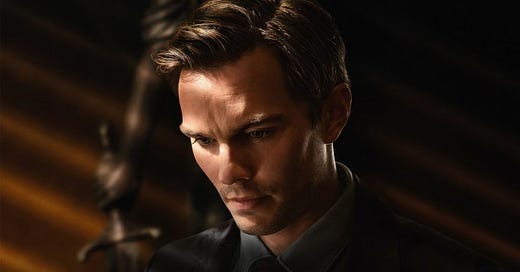Equal parts The Headless Woman and 12 Angry Men, Eastwood’s final(?) film, Juror #2, is a suitably cynical view of the American justice system. Justin Kemp (Nicholas Hoult), a recovering alcoholic hiding within an eminently punchable All-American Boy body, hits what he assumes to be a deer on his way home from a bar. When he is summoned for jury duty and the case involves the murder of a woman killed while walking along the road he was driving on that night, Justin grapples with the possibility that he may be the crime’s real culprit. Filtering Justin’s moral dilemma through the judicial process, Eastwood systematically catalogs the breakdown of justice and truth when personal interests become involved.
I’m still grappling with Juror #2. I thought it was one particularly contemptible type of film, only for it to become something of the exact opposite. Eastwood initially stacks the deck. The man on trial, the boyfriend of the deceased woman, has hired a public defender (a never hotter Chris Messina) while the lead prosecutor is the hilariously-named Faith Killebrew (Toni Collette), a woman who is depending on the case’s proximity to issues of violence against women to aid her ongoing campaign for DA. Eastwood’s most aggravating characterization concerns the jurors. Eastwood makes the two jurors adamant about the defendant’s guilt the two black jurors, leaving Justin as the white hero advocating for the defendant’s innocence. Even if Juror #2 ultimately subverts these pointedly political depictions, there’s a basis of convenience, one which extends towards the film’s narrative maneuvers (many of the particulars of the trial are pretty ridiculous), that makes Juror #2 play as a well-done exercise.
What Juror #2 does translate, especially in the courtroom proceedings, is a pervasive cynicism. The two lawyers’ friendship suggests a general disregard for the lives at stake, an apathy that translates to Eastwood’s formal construction of the trial, which he presents in clipped montage. Eastwood makes intelligent use of blinds, the gradations of light on the bodies of jurors and lawyers alike disrupting what would otherwise be painterly, classical portraits, a subtle visual metaphor for the film’s commentary on illusory ideals. Mirroring both the mentalities of the lawyers and the jurors, most of whom vocally don’t want to be there, Eastwood renders the facts of the case unimportant. Everyone just wants to make a decision and head home. The most provocative choice concerns the character of Larry (Kiefer Sutherland), the leader of Justin’s AA group who also acts as his lawyer. A direct line between the corrupted virtues of the courtroom and the more intimate space of self-improvement, Larry pushes Juror #2’s position skewering of institutional values to a more universal register.
Rather than lionize Justin, Eastwood has him decide the case in an act of blatant self-interest. In a textbook example of quasi-Bressonian elision, after the jurors make a visit to the scene of the crime where Justin has an intense conversation with one of the black jurors, Eastwood cuts directly to the verdict announcement, where a tracking shot of the jury highlights Justin’s empty seat. We only discover later that Justin about-faced, arguing for a guilty verdict as the trial approached the delivery date of his baby. As the perspective of Juror #2 shifts towards Faith’s re-investigation after the verdict, her conflicted crusade for what’s right confronts Justin with his abdication of justice, and the audience with a broader incompatibility between the system and the individual.
Juror #2 is distributed by Warner Bros. and is now playing in theaters



